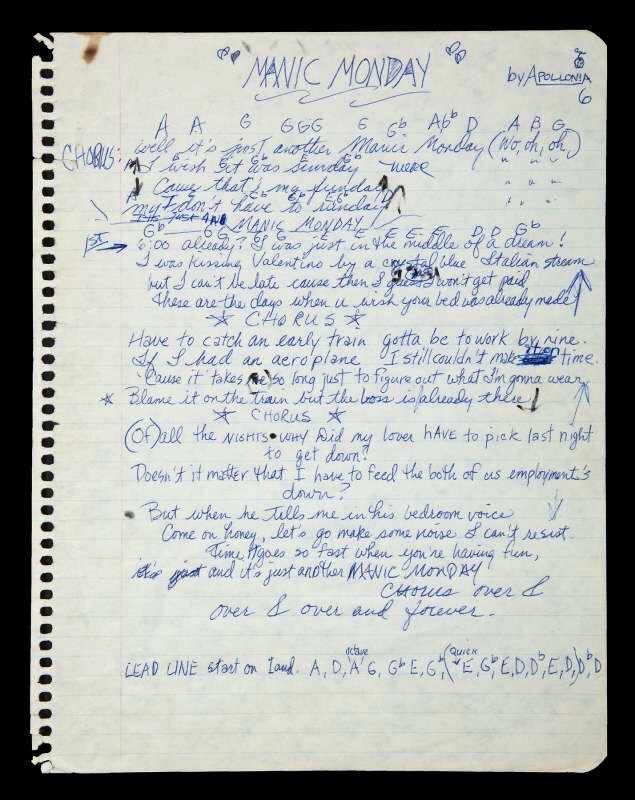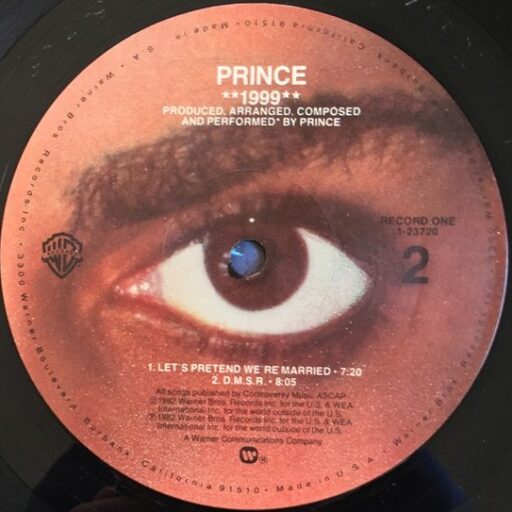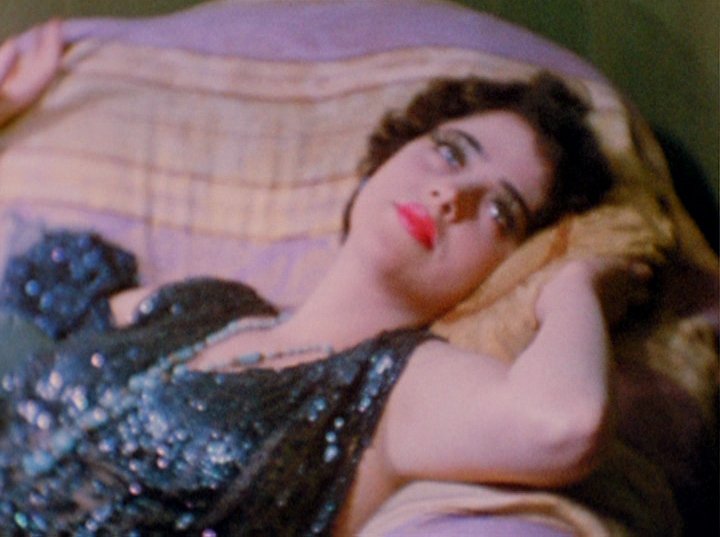Sometimes, the uncanny ease of Prince’s creative process can make it tempting to presume that songs simply sprang forth from him, like Athena from the forehead of Zeus. This is doubly true when one considers that, in at least a handful of cases, that’s pretty much exactly what happened. Engineer Peggy McCreary likes to tell the story of when Prince called her back into Sunset Sound on the morning of February 4, 1984, after a typical marathon session the previous night: “I remember going to bed at six in the morning and he called and said, ‘Can you be at the studio at noon?’ because he had dreamed a song,” she told sessionographer Duane Tudahl. “He said if he dreamed a chorus he’d call me, and he did, and it was ‘Manic Monday’”1
[Prince] said if he dreamed a chorus he’d call me, and he did, and it was ‘Manic Monday.’
Peggy McCreary

This, of course, wasn’t the first time Prince had skimmed a tune from the depths of his subconscious: “Little Red Corvette” had similarly materialized, in the artist’s own words, “between 3 or 4 catnaps” in the backseat of a car.2 More than its predecessor, however, “Manic Monday” has the hazy feel of a half-remembered dream–not least because its main melody directly echoes that of yet another dream song, “1999.” Even the ‘60s-inspired baroque pop arrangement was the result of Prince’s brain on autopilot: As he later told Keyboard magazine, he was “pushing buttons” on a Yamaha DX7 when he hit upon the “Harpsichord 1” patch, and the “sound just dictated the part.”3
There is evidence that not all of “Manic Monday,” at least, came to Prince in a dream. The lyrics, for one, were clearly written with a female singer in mind: that, or the line about “kissin’ Valentino by a crystal blue Italian stream” reveals rather more of Prince’s psyche than anyone bargained for. Indeed, Apollonia recently ruffled some feathers by claiming that she had a hand in co-writing the song herself–along with “The Glamorous Life,” which famously ended up going to Sheila E. According to the actress, Prince took a shine to her poetry, so he bought her a purple notebook from the kitschy Sunset Boulevard gift shop Aahs! so she could “float him lyrics.” “Manic Monday,” she told Drew Dempsey for the Sunset Sound YouTube channel, came from an expression she’d coined called “Smonday”: “It’s the day after Sunday, before Monday. We all need to have that day to rest, to get us ready for Monday. [Prince] was like, ‘What?’ I go, ‘Smonday. My I-don’t-have-to-run day.’ So those lyrics, fifty-fifty, Prince and myself co-wrote. That’s a story about me.”4
While Apollonia’s “fifty-fifty” claim is eyebrow-raising–it’s convenient, to say the least, that the two songs she names rank among the biggest Prince-penned hits of the 1980s–I’d argue it isn’t entirely without merit. The lyrics for “Manic Monday” (see above) clearly appear to have been written in two different hands; is it really such a stretch that one of those hands might have been hers? Even setting forensic analysis aside, it isn’t hard to imagine Prince taking inspiration from his movie co-star’s biography: Certainly, the premise of a woman making her reluctant way back to the nine-to-five grind feels closer to the life of a struggling actress than to anything in his recent experience.
It really disappointed me that [‘Manic Monday’] wasn’t on the album… It’s a great Top 40 song.
Brenda Bennett
In any case, if Apollonia is to be believed, she played at least as much of a role in giving the song away as she did in writing it. “Manic Monday” was originally slated for Apollonia 6, with Prince splitting vocal duties with the frontwoman a la “Take Me with U”; a version of this recording with Apples’ voice lower in the mix would eventually see release on 2019’s Originals compilation. The track made two early sequences of the Apollonia 6 album–the first of which Prince assembled on February 6, just one day after recording “Manic Monday”–but was axed at the eleventh hour, to the chagrin of at least two-sixths of the group. “It really disappointed me that it wasn’t on the album,” Brenda Bennett confessed to Tudahl. “It’s a great Top 40 song.”5 Prince never explained why it didn’t make the cut; but Apollonia recalls introducing him to “Hero Takes a Fall” by L.A. power-poppers the Bangles in the spring or summer of 1984. He was smitten: both by the group’s melodic chops and, more importantly, by the maid costume frontwoman Susannah Hoffs sported in the music video (see above). “I said, she should do that song,” Apollonia told Dempsey.6
On the face of it, it may seem absurd that Apollonia would so blithely hand off her best shot at a hit single. But as far as she knew at the time, she would be getting a cut of the publishing; maybe she took another look at Vanity 6’s chart history and decided she preferred the song’s chances in the hands of an up-and-coming pop group with a photogenic lead singer, rather than three unpolished bad girls in camisoles. Whatever the calculus, “Manic Monday” was off Apollonia 6; and in May of 1985, Prince finally linked up with the Bangles. Just as he had with Sheena Easton, he reached out through engineers McCreary and David Leonard, who were working on the group’s second album at the same time he was recording his eighth. “[S]omehow word got to me to go to Sunset Sound and pick up the cassette,” Hoffs told the A.V. Club in 2011. The fateful cassette reportedly also included “Jealous Girl,” which Prince had written for the Hookers project in 1981 and proceeded to try and pawn off on everyone in a skirt; but it was “Manic Monday” that caught the Bangles’ collective ear. “The title was really great,” Hoffs recalled. “It just reminded me of ‘Manic Depression,’ the Hendrix song, and had kind of a psychedelic thing.”7
The title was really great. It just reminded me of ‘Manic Depression,’ the Hendrix song, and had kind of a psychedelic thing.
Susannah Hoffs
Using Prince’s track as a template, the Bangles recorded their own version of “Manic Monday” at the nearby Sound Factory studio, with David Kahne in the producer seat and, serendipitously, Peggy McCreary as engineer. Bangles singer-guitarist Vicki Peterson would later dub it a “Banglefication” of Prince’s arrangement, to which McCreary concurred: Kahne “made that song really poppy,” she told Tudahl. “When you listen to actually what [Prince and I] cut, it was a great song, but David Kahne made it sparkle.”8 Indeed he did: capturing the retro-pop gestalt of the original, even if some of its more authentic flashes of psychedelic whimsy–most notably, the dissonant piano flourish at the end of the bridge–get lost in translation. Prince, at least, gave the arrangement his royal approval; in 2007, Peterson recalled him dropping by a Bangles tour rehearsal, where they gave him an early preview of their version. “I remember being really apologetic like, ‘Well, we don’t have the keyboards’ and he goes ‘You don’t need the keyboards.’ And then he goes, ‘It’s gonna go.’ And then he walked out, and we’re like, what does that mean[,] ‘It’s gonna go?’ What did he mean? Who says these words and then leaves?”9
In the end, His Royal Badness’ enigmatic pronouncement was borne out: the Bangles’ “Manic Monday” did “go,” all the way to a peak Hot 100 position of Number 2 on April 19, 1986 –right behind Prince’s own “Kiss” at Number 1. To this day, the song remains an ‘80s pop standard, and a feather in both artists’ respective caps. Prince, in customary fashion, took his songwriting credit under the pseudonym “Christopher”–a tip of the hat to his character in the then-upcoming Under the Cherry Moon–but his involvement was hardly a secret: As music journalist Annie Zaleski notes, no less reputable a source than Billboard outed him as the song’s writer upon its parent album’s release in January.10 Prince would also continue to tease his role in its creation: joining the Bangles onstage at the Warfield Theatre in San Francisco to sing “Manic Monday” and the rock‘n’roll chestnut “Whole Lotta Shakin’ Goin’ On,” and even playing the song himself at an August 1986 Parade tour date in Rotterdam, the Netherlands, with Revolution guitarist Wendy Melvoin on lead vocals.
If it was ever Apollonia’s ambition to land a fat publishing check with “Manic Monday,” her gambit sadly didn’t pay off; even now that the “Christopher” façade has been done away with, the song remains officially credited to Prince alone. And, while I might catch some flak for this, I say, give the lady her credit. We’re living in an era when publishing royalties are doled out for influence and interpolation, not just “songwriting” in the traditional sense; as I write these words, LGBT activist and media personality Ts Madison has a Number 1 hit on her hands for a 2020 video sampled on Beyoncé’s “COZY.” If Ms. Madison can get her well-deserved due for inspiring Queen Bey, then I’d say it’s the least we can do to compensate Apollonia for inventing “Smonday.”
(Featured Image: Yvonne Marquis in Puce Moment, Kenneth Anger, 1949; © Fantoma Films. Thanks to longtime friend of the blog Arno for adding some extra context to the bit about Prince and the Revolution’s live “cover”!)
Footnotes
- Duane Tudahl, Prince and the Purple Rain Era Studio Sessions: 1983 and 1984 – Expanded Edition (Rowman & Littlefield, 2018), p. ↩︎
- Anil Dash, “Prince’s Own Liner Notes on His Greatest Hits,” Medium, May 28, 2016. ↩︎
- Ernie Rideout, “Goodbye 1999 – O(+> produced by Prince: the Ultimate New Power Collaboration of the Millennium,” Keyboard, December 1999, republished on Prince interview archive. ↩︎
- Sunset Sound Recorders, “Apollonia Discusses Her Life w/ Prince, Filming Purple Rain & Her Work in Sunset Sound,” YouTube, May 2021. ↩︎
- Tudahl, p. 373. ↩︎
- Sunset Sound Recorders. ↩︎
- Will Harris, “Susanna Hoffs of The Bangles.” The A.V. Club, October 11, 2011. ↩︎
- Tudahl, Prince and the Parade & Sign O’ the Times Era Studio Sessions: 1985 and 1986 (Rowman & Littlefield, 2021), p. 124. ↩︎
- Ibid., pp. 124-125. ↩︎
- Annie Zaleski, “Prince Gifts the Bangles a Hit with ‘Manic Monday’: 365 Prince Songs in a Year,” Diffuser, December 22, 2017. ↩︎


Leave a Reply to ArnoCancel reply